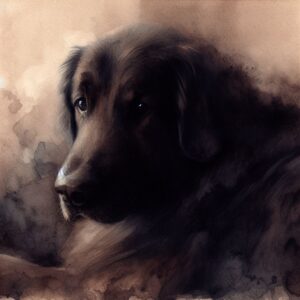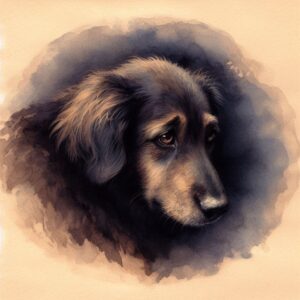Understanding How Dogs Mourn the Death of Their Loved Ones
Dogs seem to feel the same way people do when they lose a loved one. People don’t always notice the special kind of sadness that dogs feel when they lose a friend, whether it’s a person or another animal. Just like people, dogs may show different signs of grief when they lose a loved one. Knowing how dogs mourn, like how they change the way they eat or look for familiar smells, can help you understand how they’re feeling during these hard times. Thus, let us learn more about the interesting topic of how dogs deal with loss and how we can help them as they grieve.
Getting to know how dogs grieve the loss of a loved one
Here’s the link to the video: https://www.youtube.com/embed/Cp6vLj9sZQE” height=”315″ width=”560″ frameborder=”0″ The iframe is now closed.
What does it mean for a dog to mourn?
People and many other animal species, including dogs, naturally grieve and mourn when they lose someone or something important in their lives. When a dog loses a loved one, whether it’s a human family member or another dog friend, they may show signs of grief that are similar to those seen in people. Dogs can feel a lot of different emotions, and the way they grieve can show how well they connected emotionally with their loved ones.
The Emotional Link Between Dogs and the People They Love
People and dogs alike know that dogs can form strong emotional bonds with the people and dogs they love. They are very social animals that need and value company and depend on their pack or family for safety and mental support. It’s very hard for dogs to deal with the death of a family member because they form strong bonds with their owners. Dogs mourn the deaths of their loved ones in important ways that involve these emotional ties.
Dogs Show Signs of Sadness
When a dog is sad, they might show a few different behaviors that show how they are hurting. These signs can be different for each dog, but here are some common things dogs do when they are sad:
- Not wanting to eat or being interested in food
- Changes in the way they sleep, like sleeping too much or not being able to sleep at all
- Feeling tired and not having much energy
- Withdrawing from social relations and losing interest in things they used to enjoy
- More of a need for comfort and support from their human family members
Wandering around or not being able to settle down as they look for their lost loved one - No longer going to the bathroom as often, like having mistakes at home
- Signs in the body, like stomach problems or cleaning too much
It’s important to remember that these signs can also mean other health problems, so if you notice big changes in your dog’s behavior, you should definitely talk to a vet.
How Dogs Deal with Loss and Grief
When dogs lose a loved one, they go through a grieving process, just like people do. The length and intensity of this process can be different for each dog, based on their nature, what they’ve been through in the past, and how close they were to the person who died. There are usually a few steps to the mourning process, such as:
- Dogs may act confused and look for their lost friend or family member because they don’t want to accept that they are gone.
- Bargaining and searching: Dogs may do things like roaming the house or yard, looking for a dead loved one, or acting out to get attention from family members.
- Depressing and sad feelings: Dogs may look tired, distant, and down. They might become less interested in things like food, toys, and people.
- Accepting the loss and getting better: Most dogs will start to accept the loss and get better over time. They might still feel sad or aching from time to time, but they start to get used to the new reality.
Why some dogs cry and others don’t when they’re sad
How a dog grieves the death of a loved one depends on many things. Some of these factors are:
- Bond strength: How strong the bond is between the dog and the person who died can have a big effect on how hard it is to mourn.
- Age and stage of development: Dogs of different ages and stages of growth may deal with loss in different ways. For instance, puppies may find it hard to grasp the idea of death.
- Previous loss experiences: If a dog has lost or been separated from its owners more than once, it may have learned how to deal with it or become stronger.
- How the owner feels: Dogs can tell when their owners are sad, and how their human family members react to the loss can affect how they mourn.
There are some differences in how dogs and people grieve.
Even though both people and dogs go through sadness and loss, there are big differences in how they show and deal with their feelings. Due to the fact that dogs can’t talk, they use their body language and actions to show how they feel. Dogs don’t have the same cognitive understanding of death and dying as people do, which can affect how they grieve and understand the loss. They might show signs of sadness, but the way they deal with it might be different from how humans do it.
Giving Comfort to a Mourning Dog
There are a lot of things you can do to help your dog through this hard time if they have lost a loved one. Here are some strategies:
- Routine and structure: Dogs feel safe and secure when they know what to expect each day. Sticking to a regular plan can help them feel that way.
- Giving comfort and reassurance: Being there for your dog and giving them extra love, care, and touch is important. Their sadness and stress can be eased by your presence and calm voice.
- By doing gentle physical activities like walks and gentle games, you can help your dog deal with their sadness and improve their general health.
- Making a place that is safe and quiet: Allow your dog to have a comfy and quiet spot where they can go to feel safe. Arrange their favorite blankets, toys, and smells in the room.
- Gradual exposure to reminders: Slowly expose your dog to things that remind them of the person they lost, like their smell or their items. This can give them a safe and helpful place to deal with their loss.
How to Help Kids Understand When a Dog Is Sad
For kids, it’s important to help them understand and feel what a dog is feeling when it loses a loved one. Teach them to recognize and respect the signs that a dog is sad, and tell them to calm and support the dog who is sad. Teach your kids that grieving is a normal part of life and that it’s important to be kind and patient during this tough time.
When you should get help from a professional
Even though mourning is a normal reaction, there are times when you may need professional help. A veterinarian or professional animal behaviorist should be consulted if your dog’s grief lasts for a long time or if they show serious changes in behavior or physical signs. These professionals can look at what’s going on with your dog and give you advice and help that fits their needs.
Getting Over the Death of a Dog
Having to say goodbye to a beloved dog can be very hard and stressful. It is important to give yourself time to grieve and think about how you feel. Here are some things that might help you deal with the loss:
- Need help? Ask for help from friends, family, or support groups that can relate to and understand how you feel about your loss.
- Save memories: To remember your dog’s memory, make a tribute or memorial for them, like a picture book or a special keepsake.
- Think about getting professional help. If you’re having a hard time dealing with your sadness or the loss for a long time, counseling or therapy can give you a safe place to work through your feelings and get through the grieving process.
Remember that everyone deals with loss in their own way, and it’s important to let yourself mourn in your own way and at your own pace. It is possible to heal and find peace after losing a loving dog. All you need is time, patience, and support.



